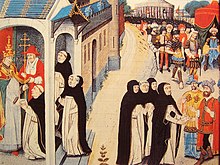Baiju Noyan
Baiju Noyan | |
|---|---|
| ᠪᠠᠶᠢᠵᠤ ᠨᠣᠶᠠᠨ | |
 Ascelin of Lombardia receiving a letter from Pope Innocent IV (left), and remitting it to the Mongol general Baiju (right). | |
| Viceroy of Mongol Empire in Near East | |
| In office 1241–1247 | |
| Appointed by | Ögedei |
| Preceded by | Chormaqan |
| Succeeded by | Eljigidei |
| In office 1251–1255 | |
| Appointed by | Möngke |
| Preceded by | Eljigidei |
| Succeeded by | Hulagu |
| Personal details | |
| Died | 1260 |
| Military service | |
| Battles/wars | Battle of Köse Dağ Siege of Baghdad (1258) |
Bayju Noyan or Baichu (Template:Lang-mn, Template:Lang-fa, Chinese: 拝住; pinyin: Bàizhù; in European sources: Bayothnoy; fl. 1228 - 1260) was a Mongol commander in Persia, Anatolia and Georgia. He was appointed by Ögedei Khan to succeed Chormagan, and expand Mongol power further in that area. He was the last direct imperial governor of the Mongol Near East, after his death Hulagu's descendants inherited domains he once commanded.
Background
Baiju belonged to Besut tribe of Mongols and was a relative of Jebe. His father was a mingghan commander under Genghis Khan and he inherited this contingent upon his death.[1]
Career
Baiju was a second-in-command of Chormaqan and took part in an attack on Jalal ad-Din near Isfahan in 1228. After Chormaqan's paralysis in 1241 Baiju took over his troops and became a tümen commander by appointment of Ögedei Khan.[2] After Ögedei's death, Baiju started to took orders from Batu, former's nephew. Baiju immediately moved against the Seljuk Sultanate of Rûm, weakening its power at the Battle of Köse Dağ on 26 June 1243. After this battle, the Sultanate became a vassal state of the Mongol Empire and was forced to release David VII Ulu. Baiju demanded the submission of Principality of Antioch too in 1244.[3] He made a raid on Abbasid Caliphate in 1245.[4] He also led Mongol tumens to raid Syria in 1246.
He received ambassadors from Pope Innocent IV in 1247. Embassy was headed by Ascelin of Lombardy and found him at Sisian, on 24 May 1247. Embassy's disrespect and Ascelin's refusal to triple genuflection angered Baiju, he insulted the pope and demanded his submission as well.[5] Ascelin left for Rome on 24 July 1247. Meanwhile he was replaced by new khagan Güyük with Eljigidei. His next two attempts to invade the Abbasid Caliphate in Iraq met less success in 1249-50. He again rose to prominence as Eljigidei and his entire family were purged by Batu for his opposition to election of Möngke Khan in 1251.
Under Baiju in the 1240s and 1250s, the Mongols retained their power in what is roughly modern-day Iran, and tolerated the independence of the Sultanate, Georgia, and petty states in Iran as clients, interfering with dynastic succession and extracting tribute militarily as necessary However, the Abbasids in Baghdad and the Assassins in the Elbruz mountains maintained their independence until the coming of Hülegü, Möngke's brother, in 1255. Baiju was supposedly reproached by Hulegu for failing to extend Mongol power further, and, indeed, was replaced by him as supreme commander as early as 1255, but served under him ably in further campaigns: against the Sultanate of Rum (to extract tribute and replace the sultan Kaykavus II) in 1256, in the assault on Baghdad in 1258, and in the advance on Syria towards Egypt in September 1259.
It is unclear what happened to Baiju after that: when the Mongol force was heavily depleted by the departure of Hülegü in 1260, the force that remained was commanded by Kitbuqa. According to Rashid al-Din, Baiju was executed by Hülegü Khan due to failing to stop Golden Horde corps fleeing from Persia to Russia and Mamluks. His tümen was given to Chormagan's son, Shiremun. While his son Adak was given a command of mingghan by Hulagu.
Portrayal in Media
- 2015-2016 — Portrayed by Barış Bağcı in Turkish historical drama series Diriliş: Ertuğrul.
Notes
References
- Cambridge Illustrated History of the Middle Ages, 1250-1520
- Claude Cahen, Pre-Ottoman Turkey
- Rene Grousset, The Empire of the Steppes
- May, Timothy (2016), The Mongol Empire: A Historical Encyclopedia, vol. 1, ABC-CLIO, ISBN 9781610693400
- Hope, Michael (2016), Power, Politics, and Tradition in the Mongol Empire and the Īlkhānate of Iran, Oxford University Press, ISBN 9780198768593
- Roux, Jean-Paul (1985), Les explorateurs au Moyen-Age, Fayard, ISBN 2-01-279339-8
